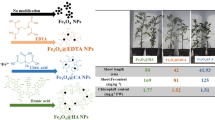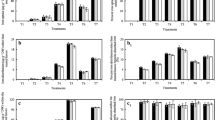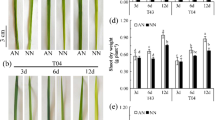Abstract
Plants developed in calcisol soils have limitations in iron nutrition, so exogenous applications of organic acids plus iron chelate can be an alternative. With the objective of knowing the answer of adding organic acids in the fertilizer solution plus a ferric chelate on the characteristics of the ferric nutrition of tomato plants developed in the calcisol soil the present experiment was established. We conducted the experiment in two stages, in the first stage studied different concentration of some organic acids: citric acid (CA), oxalic acid (OA), salicylic acid (SA), and humic complexes (HCs) combined with a FeEDDHA iron chelate, we included treatment control FeEDTA and FeEDDHA and treatment without iron in the fertilizer solution. In the second stage, we compared the best concentrations of organic acids in combination with FeEDTA iron chelate; we used to treatment control FeEDTA and FeEDDHA, and a control treatment without iron in the fertilizer solution. The best concentrations were CA 10−4 M, OA 10−4 M, SA 10−5 M, and HC 0.4 ml l−1. In the second stage, the addition of CA+FeEDTA and HC+FeEDTA increased SPAD units, chlorophyll and vitamin C contents and fruit quality improved. An increase content of Fe, Zn, and Mn in leaves was presented with treatment CA+FeEDTA and HC+FeEDTA. Addition of CA+FeEDTA improved the oxidation-reduction potential, pH and electrical conductivity (EC) of plant leachates, followed by HC+FeEDTA. Applications of CA and HC in the nutrient solution in combination with EDTA-type chelate improved the characteristics of the ferric nutrition of tomato plants developed in calcisol soil.



Similar content being viewed by others
References
Arizmendi GN, Rivera OP, De la Cruz SF, Castro MB, De la Garza RF (2011) Leaching of chelated iron in calcareous soils. TERRA Latinoamericana 29(3):231–237
Association of Official Analytical Chemists (AOAC) (1990) Official Methods of Analysis. Association of Official Analytical Chemists, 15th edn. Arlington, Virginia, p 384
Atherton JG, Rudisch J (1986) The tomato crop. Chapman and Hall. London, New York, pp 281–334
Balzarini M, Di Rienzo A, Cazanoves F, González I, Tablada M, Guzmán W, Robledo W (2008) InfoStat software estadístico InfoStat versión 2008. Grupo InfoStat, FCA, Universidad Nacional de Córdoba, Argentina, Manual de usuario
Briat JF, Dubos C, Gaymard F (2015) Iron nutrition, biomass production, and plant product quality. Trends Plant Sci 20:33–40
Brumbarova T, Bauer P, Ivanov R (2015) Molecular mechanisms governing Arabidopsis iron uptake. Trends Plant Sci 20(2):124–133
Chatterjee D, Datta SC, Manjaiah KM (2015) Effect of citric acid treatment on release of phosphorus, aluminium and iron from three dissimilar soils of India. Arch Agron Soil Sc 61:105–117
Ehsan S, Ali S, Noureen S, Mahmood K, Farid M, Ishaque W, Rizwan M (2014) Citric acid assisted phytoremediation of cadmium by Brassica napus L. Ecotox Environ Safe 106:164–172
Fish WW, Perkins-Veazie P, Collins JJ (2002) A quantitative assay for lycopene that utilizes reduced volumes of organic solvents. J Food Composit Ann 15:309–317
Frohne T, Rinklebe J, Diaz-Bone RA, Du Laing G (2011) Controlled variation of redox conditions in a floodplain soil: impact on metal mobilization and biomethylation of arsenic and antimony. Geoderma 160:414–424
Guil-Guerrero JL, Rebolloso-Fuentes MM (2009) Nutrient composition and antioxidant activity of eight tomato (Lycopersicon esculentum) varieties. J Food Compos Anal 22(2):123–129
Hill T, Lewicki P (2007) STATISTICS: methods and applications. StatSoft Inc, Tulsa
Khaled H, Fawy HA (2011) Effect of different levels of humic acids on the nutrient content, plant growth, and soil properties under conditions of salinity. Soil & Water Res 6:21–29
Kong J, Dong Y, Zhang X, Wang Q, Xu L, Liu S, Hou J, Fan Z (2015) Effects of exogenous salicylic acid on physiological characteristics of peanut seedlings under iron-deficiency stress. J. Plant Nutrition 38:127–144
Márquez-Quiroz C, De-la-Cruz-Lázaro E, Osorio-Osorio R, Sánchez-Chávez E (2015) Biofortification of cowpea beans with iron: iron’s influence on mineral content and yield. Soil Sci Plant Nutr 15(4):839–847
Mora V, Bacaicoa E, Zamarreño AM, Aguirre E, Garnica M, Fuentes M, García-Mina JM (2010) Action of humic acid on promotion of cucumber shoot growth involves nitrate-related changes associated with the root-to-shoot distribution of cytokinins, polyamines and mineral nutrients. J Plant Physiol 167(8):633–642
Moradi N, Sadaghiani MR, Sepehr E, MandoulakanI BA (2012) Effects of low-molecular-weight organic acids on phosphorus sorption characteristics in some calcareous soils. Turk J Agric For 36(4):459–468
Mujtaba A, Masud T (2014) Enhancing post harvest storage life of tomato (Lycopersicon esculentum Mill.) cv. Rio Grandi using calcium chloride. American-Eurasian J. Agric. & environ. Sci. 14(2):143–149
Nag A, Gupta H (2014) Physicochemical analysis of some water ponds in and around Santiniketan, West Bengal, India. Int J Environ Sci 4(5):676–682
Nour V, Trandafir I, Ionica ME (2013) Antioxidant compounds, mineral content and antioxidant activity of several tomato cultivars grown in Southwestern Romania. Not Bot Horti Agrobo 41:136–142
Nozoye T, Nagasaka S, Bashir K, Takahashi M, Kobayashi T, Nakanishi H, Nishizawa NK (2014) Nicotianamine synthase 2 localizes to the vesicles of iron-deficient rice roots, and its mutation in the YXXf or LL motif causes the disruption of vesicle formation or movement in rice. Plant J 77(2):246–260
Orndorff, Z.W., Daniels, W.L., Beck, M., Eick, M.J. 2010. Leaching potentials of coal spoil and refuse: acid-base interactions and electrical conductivity. p. 736–766. In: R.I. Barnhisel (ed.) Proc. Am. Soc. Min. Reclam., Pittsburgh, PA. 5–11. ASMR, Lexington, KY
Padayatt SJ, Daruwala R, Wang Y, Eck PK, Song J, Koh WS, Levine M (2001) Vitamin C: from molecular actions to optimum intake. In: Cadenas E, Packer L (eds) Handbook of antioxidants. CRC Press. Washington, DC, pp 117–145
Redel Y, Cartes P, Demanet R, Velásquez G, Poblete-Grant P, Bol R, Mora ML (2016) Assessment of phosphorus status influenced by Al and Fe compounds in volcanic grassland soils. Soil Sci Plant Nutr 16(2):490–506
Rengel Z (2015) Availability of Mn, Zn and Fe in the rhizosphere. Soil Sci Plant Nutr 15(2):397–409
Sánchez-Rodríguez AR, del Campillo MC, Torrent J, Jones DL (2014) Organic acids alleviate iron chlorosis in chickpea grown on two p-fertilized soils. J Soil Sci Plant Nutr 14(2):292–303
Schmidt W (2003) Iron solutions: acquisition strategies and signaling pathways in plants. TRENDS Plant Science 8(4):188–193
Steiner AA (1961) A universal method for preparing nutrient solutions of a certain desired composition. Plant Soil 15:134–154
Ström L, Owen AG, Godbold DL, Jones DL (2001) Organic acid behavior in calcareous soil: sorption and biodegradation rates. Soil Biol Biochem 33:2125–2133
Ström L, Owen AG, Godbold DL, Jones DL (2005) Organic acid behaviour in a calcareous soil implications for rhizosphere nutrient cycling. Soil Biol Biochem 37(11):2046–2054
Torres AP, Mickelbart MV, Lopez RG (2010) Leachate volume effects on pH and electrical conductivity measurements in containers obtained using the pour-through method. HortTechnology 20(3):608–611
USDA. 1997. United states department of agriculture. Agricultural marke-ting Service. United States standards for grades of fresh tomatoes
Vernon P (1960) Spectrophotometric determinations of chlorophylls and pheophtins in plant extracts. Anal Chem 32(9):1144–1150
Ylivainio K (2010) Effects of iron(III) chelates on the solubility of heavy metals in calcareous soils. Environ Pollut 158(10):3194–3200
Yong-liang C, Yu-qiang G, Shi-jie H, Chun-jing Z, Yu-mei Z, Guo-ling C (2002) Effect of root derived organic acids on the activation of nutrients in the rhizosphere soil. J Forestry Research 13(2):115–118
Acknowledgments
This study is financially supported by the CONACYT and Arysta LifeScience.
Author information
Authors and Affiliations
Corresponding author
Additional information
Publisher’s Note
Springer Nature remains neutral with regard to jurisdictional claims in published maps and institutional affiliations.
Rights and permissions
About this article
Cite this article
Pérez-Labrada, F., Benavides-Mendoza, A., Juárez-Maldonado, A. et al. Organic acids combined with Fe-chelate improves ferric nutrition in tomato grown in calcisol soil. J Soil Sci Plant Nutr 20, 673–683 (2020). https://doi.org/10.1007/s42729-019-00155-3
Received:
Accepted:
Published:
Issue Date:
DOI: https://doi.org/10.1007/s42729-019-00155-3




